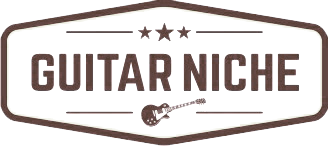Painless Guitar Chord Theory
Guitar chord theory is a subject that worries a lot of players, but if you’ve ever wondered how guitar chords are created, or you want to figure out chord voicings in other registers on the fretboard it’s a priceless bit of knowledge.
It also allows you to see links between scales and chords, very useful if you intend on a lead part following a specific chord progression or landing on a specific chord tone.
It all starts with the major scale of the key you are trying to figure out chord voicings in.
For the purpose of this lesson I will use the A Major Scale.
The A major scale:
| I | II | III | IV | V | VI | VII |
| A | B | C# | D | E | F# | G# |
The concept applies in every key, as long as you start with your major scale and remember the distance between each interval (Tone, Tone, Semi-tone, Tone, Tone, Tone, Semi-tone).
![]()
Major Chords
Major Chords are made up from the I, III and V internals of a major scale. In the key of A Major our major chord would be:
I III V
A C# E
Major chords are made up of only the I, III and V intervals from the scale.
 |
 |
 |
| A Major Open Position | A Major 6 String Barre | A Major 5 String Barre |
![]()
Minor Chords
Minor chords are made up of the I, bIII and V intervals of a major scale. In the key of A Major our minor chord would be:
I bIII V
A C E
The note C (Which is our flat or minor 3rd) is not in the key of A Major, but flattening this 3rd interval of the scale is where we get our minor quality.
 |
 |
 |
| A Minor Open Position | A Minor 6 String Barre | A Minor 5 String Barre |
![]()
![]()
Recommended Online Guitar Lessons
![]()
Dominant 7th Chords (Also known as 7 chords)
Dominant 7th chords are made up of the I, III, V and bVII intervals of a major scale. In the key of A Major our dominant 7th chord would be:
I III V bVII
A C# E G
The dominant 7 chord shares the I, III, V trial of a Major chord, with an added flattened 7th note. In the key of A Major, the VII note in our scale is a G#. As a dominant 7 chord requires the VII to be flattened, this gives us a G note.
 |
 |
 |
| A7 Open Position | A7 6 String Barre | A7 5 String Barre |
![]()
Major 7th Chords
Major 7th chords are made up of the I, III, V and VII intervals of a major scale. In the key of A Major our major 7th chord would be:
I III V VII
A C# E G#
The Major 7 chord can be created by just adding a VII note to a standard Major (I III V) note grouping on the fretboard.
 |
 |
 |
| A Major7 Open Position | A Major7 6 String Barre | A Major7 5 String Barre |
![]()
Recommended Help for Easily Understanding Chords
![]()
Minor 7th Chords
Minor 7th chords are made up of the I, bIII, V and bVII intervals of a major scale. In the key of A Major our minor 7th chord would be:
I bIII V bVII
A C E G
The minor 7 chord is a minor chord trial (I bIII V) with an added bVII note added. This chord is great for adding a sombre vibe to your chord progressions. Try playing blues with Min7 chords and see where it takes you.
 |
 |
 |
| A Minor7 Open Position | A Minor7 6 String Barre | A Minor7 5 String Barre |
For each chord grouping I have included 3 variations across the fretboard to get you started. These shapes are all transposable between all keys with the root note being the lowest note in every chord shape.
Once you become familiar and comfortable with the intervals that make up the chords, you can attempt to find these groupings in non-familiar orientations across the fretboard.
Chord theory will open many doors and allow you to find new voicings for chords across the guitar.
About the Author
Leigh Fuge is a guitar tutor and professional guitarist from the UK. He divides his time between session work, playing with his band and teaching. He has a passion for sharing information and helping students across the globe improve their craft. He is a regular contributor to many online guitar publications and has taught hundreds of students in both face to face and Skype guitar lessons.



Leave a Reply